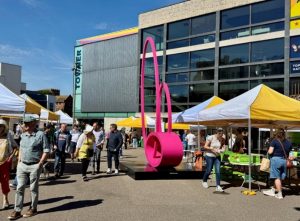Biodiversity and conservation on the Pevensey Levels
By Sam Powell
On a calm Sunday in May, the Eastbourne Eco Action Network (EEAN) led a walk across the Pevensey Levels, a land where water meets land, history seeps into the soil and rare life exists.
Following the Pevensey Castle and Pevensey Haven Circular, the walk traced a quiet path through one of southern Britain’s most ecologically rich wetlands. Here, the past folds into the present: the 290 AD Roman fort (Anderida) and the 12th-13th century Norman castle echo across the lowland marsh, where grass beds bow in the breeze.

Pevensey Haven
Photo credit: Sam Powell
A living wetland
Between Eastbourne, Bexhill-on-Sea and Hailsham, the Levels stretch across some 3,600 hectares of protected Site of Special Scientific Interest (SSSI), also designated as a Ramsar site and Special Area of Conservation (SAC). Its complex channels, sluices and ditches, controlled by the Pevensey and Cuckmere Water Level Management Board, Environment Agency, Sussex Wildlife Trust (SWT), East Sussex County Council and local district councils, support both agriculture and one of England’s last great wetland ecologies.
To walk here is to step into a world alive with sound and stillness. Reed warblers sang; a heron rose from a “scrape” pool, and below the Pevensey Haven water’s surface, bream, carp, pike, roach, chub, tench, eel and perch swam unseen. Overhead, the occasional geese honked as grass whispered in the wind.
Long ago, the sea lapped the base of Pevensey Castle. Today it lies a mile away, edged back by centuries of land reclamation and natural processes. But freshwater still shapes life here.

Quinces and Pippin apples growing in a community orchard across from Pevensey Castle.
Photo credit: Sam Powell.
Rare and at-risk
Not all life is as easy to see. The lapwing, once common, is now red-listed in the UK. The yellow wagtail and snipe have also become rarer. In still corners, the great silver water beetle, shining ram’s-horn snail and fen raft spider continue their quiet existence.
Amphibians such as the great crested newt, which moves among aquatic plants and is protected under UK and EU law, rely on clean water, as do elusive barbastelle bats and water voles that slip silently through the reeds.
All are vulnerable to pollution, especially from the 77 combined and emergency sewer overflows mapped within the Cuckmere and Pevensey Levels catchment.

Andrew Durling (right) and Robert McGowan (left) led the walk across the Levels.
Photo credit: Sam Powell.
Guardians of the Levels
In response, conservation efforts have arisen. Formed in 2018, the Pevensey Levels Farmers Cluster Group (PLFCG), a sixty-strong coalition, supported by the Countryside Stewardship Facilitation Fund has worked to restore balance through sustainable land management.
SWT, with its 150-hectare reserve purchased in 1996, partners with PLFCG to deepen that work. Through its Network for Nature project, ditches are reprofiling, culverts set, scrapes formed, shallow pools to welcome waterbirds and deeper ponds dug.
As SWT’s Jamie Parsons describes it, this is a reserve alive with “rare species such as the Fen Raft Spider, at least 25 rare aquatic molluscs, 16 species of Odonata such as Hairy Dragonfly, along with a huge number of rare aquatic invertebrates and plants.”
We met Martin Hole, owner of Montague Farm, National Farmers Union South East chair and co-founder of the PLFCG. A lapwing conservationist and lover of rooks, he spoke of water levels, habitat and the land’s slow healing.
In a field of Martin’s, a sea of almost 4,000 green-winged orchids bloomed among 20 grass species. Considered “near threatened” in the UK, they’ve returned with quiet determination, living proof of what patient care can restore.
As the walk neared its end, a fork in the path offered two choices, one toward the local pub, the other back to the railway station and modern life. The group parted gently, with the low sun stretching shadows over the grass.
Behind us, the Levels lay calm, echoing with birdsong, holding centuries of memory and the fragile promise of continued renewal.

Martin Hole talks about biodiversity, conservation and farming on the Pevensey Levels.
PhotoCredit: Sam Powell.

Green-winged orchids
Photo credit: Sam Powell.




























































